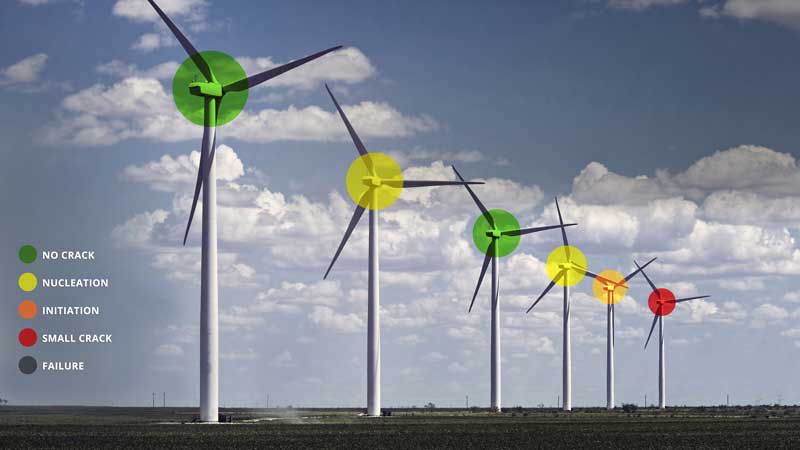Digitalization when combined with material science gives operators the forward visibility to build strategic plans that lower their levelized cost of energy by up to 13%.
The data analytics that come from building a digital model of each individual asset and the simulation of major systems and components under the unique loading and operational conditions drive the business model for the operator. It starts from the beginning at the pre-capital expenditure phase when the developer is choosing which wind turbine original equipment manufacturer (OEM) to use. The software models the wear of the drivetrain components at a microstructural level, predicting the earliest point in time that cracks initiate in the subsurface. This allows the software to calculate the predicted life over the next 30 years, and provide the developer with side by side comparisons of each OEM offering. Having the right configuration and design for the site’s conditions can help the operator in negotiating the terms and conditions of insurance and warranties, because the developer is Buying on Life and reliability, not just price.
Once the wind farm is built, the assets are connected to the SCADA systems, which enables live monitoring of the site. The SCADA provides important analytics to the DigitalClone model, which updates the watchlist of assets, explaining which assets have crack propagation, subsurface crack initiation and no crack. Sentient will provide recommendations for actions to accompany the assets on the watch list based on the following criteria: assets that need attention immediately, actions to take to prevent replacement and actions to keep assets in good health.
By knowing the bill of materials inside of the drivetrain, the operator is able to dive even deeper into the data, understanding at a component level where damage is initiated, it’s specific location and when failure will occur. If the data suggests high probability of early component failure, a root cause analysis can determine who should pay – the operator or the warranty provider. At the end of warranty inspection, this information is particularly important because it can help in warranty claim litigation.
The fleet risk assessment, which pairs the end of warranty inspection with material science, gives the operator insight into which maintenance provider carries the lowest cost impact – a full service agreement with OEM that has high premiums, an independent service provider with shared risk, or develop an in-house maintenance strategy, where the operator assumes all of the risk. With digitalization, the operator can more confidently move to an ISP or in house servicing strategy, because it has more accurate data and insight into its planned and unplanned maintenance schedules and budgetary needs.
The visibility into the failure rates at a 5-year scale, enables multi-year budgeting and predictive health maintenance, including 20%-30% more up-tower component replacements and other life extension actions. This can equate to between major cost of energy savings because there will be significantly less unplanned major events and extended outages. Having accurate failure rate information based on science, far in advance of CBM systems, also facilitates a reduction in inventory carrying costs, enabling direct communication and better terms and conditions with suppliers.
Finally, digitalization provides valuable insight into the long term profitability of the wind farm. Operators can evolve their business plan and develop strategies that define, for instance, the impact of remanufacturing their drivetrains. Or the benefit of recommended life extension solutions that can help the operator achieve 25-to 30-year asset life. With digitalization, an ROI calculator measures the profitability of each specific site and show how each wind farm is performing, and indicates where improvements can be made to increase productivity.
We’ll be at the WindEurope Hamburg show Sept. 27-30 discussing Digitalization of Wind Farms. Meet us there!
